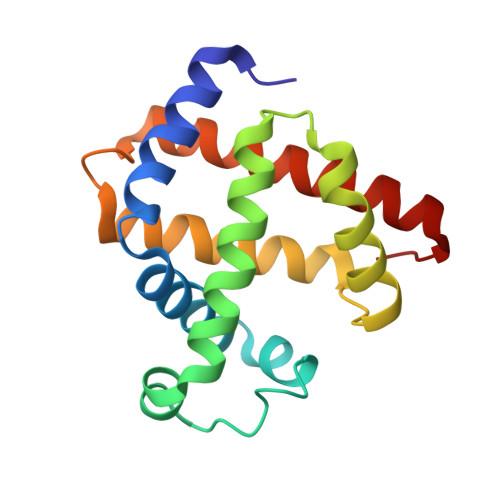Structures of K42N and K42Y sperm whale myoglobins point to an inhibitory role of distal water in peroxidase activity.
Wang, C., Lovelace, L.L., Sun, S., Dawson, J.H., Lebioda, L.(2014) Acta Crystallogr D Biol Crystallogr 70: 2833-2839
- PubMed: 25372675
- DOI: https://doi.org/10.1107/S1399004714017787
- Primary Citation of Related Structures:
4OF9, 4OOD - PubMed Abstract:
Sperm whale myoglobin (Mb) functions as an oxygen-storage protein, but in the ferric state it possesses a weak peroxidase activity which enables it to carry out H2O2-dependent dehalogenation reactions. Hemoglobin/dehaloperoxidase from Amphitrite ornata (DHP) is a dual-function protein represented by two isoproteins DHP A and DHP B; its peroxidase activity is at least ten times stronger than that of Mb and plays a physiological role. The `DHP A-like' K42Y Mb mutant (K42Y) and the `DHP B-like' K42N mutant (K42N) were engineered in sperm whale Mb to mimic the extended heme environments of DHP A and DHP B, respectively. The peroxidase reaction rates increased ∼3.5-fold and ∼5.5-fold in K42Y and K42N versus Mb, respectively. The crystal structures of the K42Y and K42N mutants revealed that the substitutions at position 42 slightly elongate not only the distances between the distal His55 and the heme iron but also the hydrogen-bonding distances between His55 and the Fe-coordinated water. The enhanced peroxidase activity of K42Y and K42N thus might be attributed in part to the weaker binding of the axial water molecule that competes with hydrogen peroxide for the binding site at the heme in the ferric state. This is likely to be the mechanism by which the relationship `longer distal histidine to Fe distance - better peroxidase activity', which was previously proposed for heme proteins by Matsui et al. (1999) (J. Biol. Chem. 274, 2838-2844), works. Furthermore, positive cooperativity in K42N was observed when its dehaloperoxidase activity was measured as a function of the concentration of the substrate trichlorophenol. This serendipitously engineered cooperativity was rationalized by K42N dimerization through the formation of a dityrosine bond induced by excess H2O2.
Organizational Affiliation:
Department of Chemistry and Biochemistry, University of South Carolina, Columbia, SC 29208, USA.

















